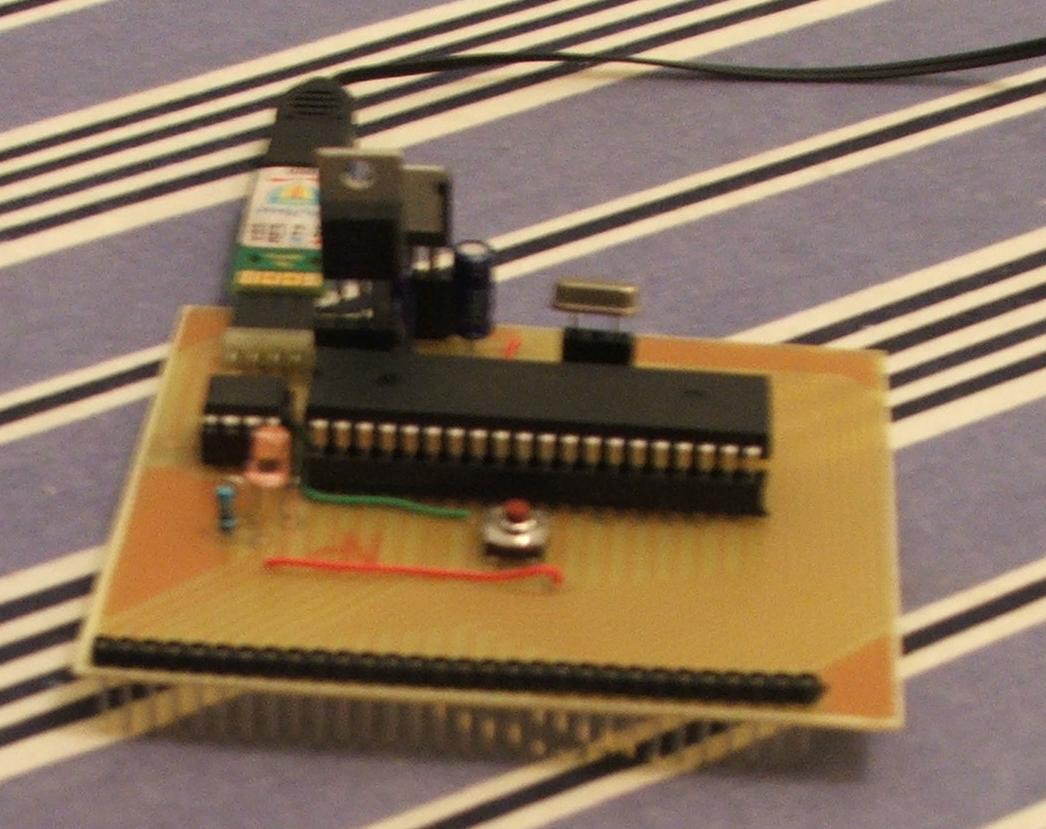Propeller Magic Smoke Board
I blow alot of propeller chips because I'm sometimes careless with the 5V. I have the Education kit, so my breadboard is all set up when I blow a chip. All I have to do is drop in a new chip, maybe replace a regulator or two, and presto, good as new. However, I've found that some of the times the reason that I blow the chip in the first place is because the loose wires getting crossed once in a while.
My solution is to make a PCB that is all hard wired and can have all the IO pins out front and ready to plug straight into my breadboard. This allows for easy transition from project to project, too. I'll attach the finished board in a bit, but I'm just curious if anyone would be interested in some of these? I can make these boards at home for around $5, and could ship them via USPS First Class Mail for less than a buck. Anyone interested? Think of it as a protoboard-breadboard hybrid. It's in a nice neat PCB, but all the parts can be easily replaced with little or no soldering.
Post Edited (Philldapill) : 11/30/2008 5:21:40 AM GMT
My solution is to make a PCB that is all hard wired and can have all the IO pins out front and ready to plug straight into my breadboard. This allows for easy transition from project to project, too. I'll attach the finished board in a bit, but I'm just curious if anyone would be interested in some of these? I can make these boards at home for around $5, and could ship them via USPS First Class Mail for less than a buck. Anyone interested? Think of it as a protoboard-breadboard hybrid. It's in a nice neat PCB, but all the parts can be easily replaced with little or no soldering.
Post Edited (Philldapill) : 11/30/2008 5:21:40 AM GMT




Comments
▔▔▔▔▔▔▔▔▔▔▔▔▔▔▔▔▔▔▔▔▔▔▔▔
PG
www.leonheller.com/Propeller/
Leon
▔▔▔▔▔▔▔▔▔▔▔▔▔▔▔▔▔▔▔▔▔▔▔▔
Amateur radio callsign: G1HSM
Suzuki SV1000S motorcycle
Oh, btw, this board has pins that connect right into the breadboard, but I may just have female pin headers on the board. With female headers, you would have to connect each pin to the board with a jumper wire, which may be useful sometimes...
By the way, Leon, I like your board. Simple, and to the point... But how do you connect anything to it? I see the headers in your schematic, but the actual board seems to be lacking them.
Would you mind sharing your PCB making process in the Sandbox thread?
I'd love to hear how you are doing this.
OBC
▔▔▔▔▔▔▔▔▔▔▔▔▔▔▔▔▔▔▔▔▔▔▔▔
New to the Propeller?
Getting started with a Propeller Protoboard?
Check out: Introduction to the Proboard & Propeller Cookbook 1.4
Updates to the Cookbook are now posted to: Propeller.warrantyvoid.us
Got an SD card connected? - PropDOS
Just FYI to everyone, I'm not sure if I was clear about the board, but the cost I was refering to was just the PCB itself - no components on it. If enough people wanted one of these boards, I suppose I could have the design sent off to a PCB fabricator which would be cheaper. Again, I'd sell it around "at cost".
Ok, new topic related to this board... It just occured to me that there may be problems with the really long tracks. Pins 0-15 might not be a problem, but pin 28 has the longest path that is parallel to other tracks... about 4 inches. Could this introduce enough stray capacitance or inductance to hinder some higher speed applications? Again, this IS only a prototyping board, not really intended for final projects, but still...
They aren't intended for headers. I just run wires from the pads to components on the breadboarding area. I just drill holes as I need them, of course, for additional parts. I could design something similar with headers for circuits on other PCBs, I'm doing that for another chip I'm using.
Leon
▔▔▔▔▔▔▔▔▔▔▔▔▔▔▔▔▔▔▔▔▔▔▔▔
Amateur radio callsign: G1HSM
Suzuki SV1000S motorcycle
I use the standard TV output pin group. I think you'll have problems using the EEPROM pins because of the resistors loading the signals.
Leon
▔▔▔▔▔▔▔▔▔▔▔▔▔▔▔▔▔▔▔▔▔▔▔▔
Amateur radio callsign: G1HSM
Suzuki SV1000S motorcycle
It shouldn't cause any problems. The maximum speed you can waggle an output is under 10 MHz (I think) and 4" is negligible in terms of a 10 MHz wavelength.
I was thinking of redesigning my board with a similar track arrangement. I did something similar with a PIC a few weeks ago.
Leon
▔▔▔▔▔▔▔▔▔▔▔▔▔▔▔▔▔▔▔▔▔▔▔▔
Amateur radio callsign: G1HSM
Suzuki SV1000S motorcycle
Leon
▔▔▔▔▔▔▔▔▔▔▔▔▔▔▔▔▔▔▔▔▔▔▔▔
Amateur radio callsign: G1HSM
Suzuki SV1000S motorcycle
If anyone is interested in one of these when it's done, let me know via private message so we can exchange info. Also, any suggestions, again, let me know as well.
Leon
▔▔▔▔▔▔▔▔▔▔▔▔▔▔▔▔▔▔▔▔▔▔▔▔
Amateur radio callsign: G1HSM
Suzuki SV1000S motorcycle